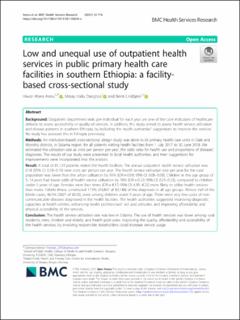| dc.description.abstract | Background: Outpatient department visits per individual for each year are one of the core indicators of healthcare delivery to assess accessibility or quality of services. In addition, this study aimed to assess health service utilisation and disease patterns in southern Ethiopia, by including the health authorities’ suggestions to improve the services. No study has assessed this in Ethiopia previously.
Methods: An institution-based cross-sectional design study was done in 65 primary health care units in Dale and Wonsho districts, in Sidama region, for all patients visiting health facilities from 1 July 2017 to 30 June 2018. We estimated the utilisation rate as visits per person per year, the odds ratio for health use and proportions of diseases’ diagnoses. The results of our study were presented to local health authorities, and their suggestions for improvements were incorporated into the analysis.
Result: A total of 81,129 patients visited the health facilities. The annual outpatient health service utilisation was 0.18 (95% CI: 0.18–0.19) new visits per person per year. The health service utilisation rate per year for the rural population was lower than the urban utilisation by 91% (OR = 0.09; 95% CI: 0.08–0.09). Children in the age group of 5–14 years had lower odds of health service utilisation by 78% (OR = 0.22; 95% CI: 0.21–0.23), compared to children under 5 years of age. Females were four times (OR = 4.17; 95% CI: 4.09–4.25) more likely to utilise health services than males. Febrile illness constituted 17.9% (14,847 of 83,148) of the diagnoses in all age groups. Almost half of the febrile cases, 46.5% (3827 of 8233), were among children under 5 years of age. There were very few cases of non-communicable diseases diagnosed in the health facilities. The health authorities suggested improving diagnostic capacities at health centres, enhancing health professionals’ skill and attitudes, and improving affordability and physical accessibility of the services.
Conclusion: The health service utilisation rate was low in Sidama. The use of health services was lower among rural residents, men, children and elderly, and health post users. Improving the quality, affordability and accessibility of the health services, by involving responsible stakeholders could increase service usage. | en_US |

